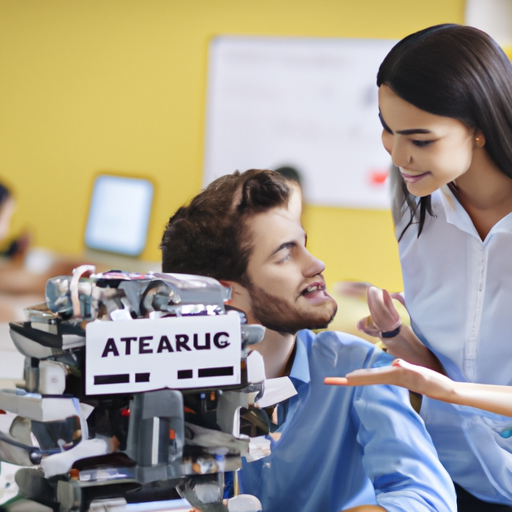-
Table of Contents
- Introduction
- The Future of Robotics: What Can We Expect in the Coming Years?
- The Challenges of Robotics: What Are the Limitations?
- The Benefits of Robotics in Manufacturing and Other Industries
- The Different Types of Robotics and Their Uses
- The History of Robotics: How Robotics Has Evolved Over Time
- Conclusion
“Unlock the Future of Robotics with Do You Know About Robotics!”
Introduction
Robotics is a rapidly growing field of technology that has the potential to revolutionize the way we live and work. Robotics is the science and engineering of robots, which are machines that can be programmed to perform a variety of tasks. Robotics is used in a wide range of industries, from manufacturing to healthcare, and is becoming increasingly important in our everyday lives. Robotics is a fascinating and complex field, and it is important to understand the basics of robotics in order to appreciate its potential. In this article, we will explore the basics of robotics and discuss some of the most exciting applications of robotics today.
The Future of Robotics: What Can We Expect in the Coming Years?
The future of robotics is an exciting prospect, and one that is sure to bring about a great deal of change in the coming years. Robotics technology has already made a significant impact on many industries, from manufacturing to healthcare, and its potential for further development is immense. In the coming years, we can expect to see robotics technology become increasingly sophisticated and capable of performing a wide range of tasks.
One of the most significant developments in robotics technology is the emergence of artificial intelligence (AI). AI is a form of computer programming that enables robots to learn and adapt to their environment. This technology has already been used in a variety of applications, from self-driving cars to medical diagnosis. In the future, AI will become even more advanced, allowing robots to interact with humans in more natural ways. This could lead to robots being used in a variety of roles, from customer service to medical care.
Another area of robotics technology that is likely to see significant advances in the coming years is the development of autonomous robots. Autonomous robots are capable of performing tasks without any human intervention. This technology has already been used in a variety of applications, from self-driving cars to robotic vacuum cleaners. In the future, autonomous robots will become even more advanced, allowing them to perform more complex tasks and interact with humans in more natural ways.
Robotics technology is also likely to become more affordable in the coming years. As the technology becomes more advanced, the cost of producing robots will decrease, making them more accessible to a wider range of people. This could lead to robots being used in a variety of roles, from customer service to medical care.
Finally, robotics technology is likely to become more integrated into our everyday lives. As robots become more advanced, they will be able to interact with humans in more natural ways, allowing them to perform a variety of tasks. This could lead to robots being used in a variety of roles, from customer service to medical care.
Overall, the future of robotics is an exciting prospect, and one that is sure to bring about a great deal of change in the coming years. Robotics technology has already made a significant impact on many industries, and its potential for further development is immense. In the coming years, we can expect to see robotics technology become increasingly sophisticated and capable of performing a wide range of tasks.
The Challenges of Robotics: What Are the Limitations?
Robotics is a rapidly growing field of technology that has the potential to revolutionize many aspects of our lives. However, despite its potential, robotics is not without its limitations. In this article, we will explore some of the challenges that robotics faces and the limitations that come with them.
One of the biggest challenges of robotics is the lack of artificial intelligence. While robots can be programmed to perform certain tasks, they lack the ability to think and reason like humans. This means that robots are limited in their ability to make decisions and adapt to changing environments. As a result, robots are often unable to complete tasks that require complex problem-solving or creative thinking.
Another limitation of robotics is the lack of dexterity. While robots can be programmed to perform certain tasks, they are limited in their ability to manipulate objects with precision. This means that robots are often unable to complete tasks that require fine motor skills, such as assembling small parts or performing delicate surgeries.
Robots are also limited in their ability to interact with humans. While robots can be programmed to recognize and respond to certain commands, they lack the ability to understand and interpret human emotions. This means that robots are often unable to interact with humans in a meaningful way, which can limit their usefulness in certain applications.
Finally, robots are limited in their ability to learn. While robots can be programmed to perform certain tasks, they lack the ability to learn from their mistakes and adapt to new situations. This means that robots are often unable to improve their performance over time, which can limit their usefulness in certain applications.
Despite these limitations, robotics is still a rapidly growing field of technology with the potential to revolutionize many aspects of our lives. As technology continues to advance, it is likely that these limitations will be overcome and robots will become even more capable and useful.
The Benefits of Robotics in Manufacturing and Other Industries
Robotics has become an increasingly important part of the manufacturing and other industries in recent years. This technology has revolutionized the way that many businesses operate, providing a number of benefits that can help to improve efficiency, reduce costs, and increase productivity.
One of the primary benefits of robotics in manufacturing and other industries is the ability to automate processes. By using robots to perform repetitive tasks, businesses can reduce the amount of time and labor required to complete a job. This can help to reduce costs and increase efficiency, as well as improve the quality of the finished product. Additionally, robots can be programmed to perform tasks with greater accuracy and precision than humans, which can help to reduce errors and improve the overall quality of the product.
Robots can also be used to increase safety in the workplace. By using robots to perform dangerous tasks, businesses can reduce the risk of injury to their employees. Additionally, robots can be programmed to work in hazardous environments, such as those with high temperatures or hazardous materials, which can help to reduce the risk of exposure to these elements.
Robots can also be used to increase productivity. By using robots to perform tasks that would otherwise require multiple employees, businesses can reduce the amount of time and labor required to complete a job. This can help to reduce costs and increase efficiency, as well as improve the quality of the finished product.
Finally, robots can be used to reduce the amount of waste produced in the manufacturing process. By using robots to perform tasks with greater accuracy and precision than humans, businesses can reduce the amount of scrap material produced. This can help to reduce costs and increase efficiency, as well as improve the overall quality of the product.
Overall, robotics has revolutionized the way that many businesses operate, providing a number of benefits that can help to improve efficiency, reduce costs, and increase productivity. By using robots to automate processes, increase safety, and reduce waste, businesses can improve their bottom line and create a more efficient and productive workplace.
The Different Types of Robotics and Their Uses
Robotics is a rapidly growing field of technology that has a wide range of applications. Robotics is the science of designing, constructing, and operating robots. Robots are machines that are capable of performing complex tasks autonomously or with minimal human intervention. They are used in a variety of industries, from manufacturing to healthcare, and are becoming increasingly important in our daily lives.
Industrial robots are used in manufacturing and production processes. They are designed to perform repetitive tasks with precision and accuracy. Industrial robots are used to assemble products, weld parts, and package items. They are also used to move materials around a factory or warehouse. Industrial robots are typically programmed to follow a set of instructions and can be programmed to perform a variety of tasks.
Service robots are used to assist humans in a variety of tasks. These robots are designed to interact with people and can be used in healthcare, hospitality, and retail settings. Service robots can be used to deliver food and drinks, provide customer service, and assist with medical procedures. They can also be used to provide companionship and emotional support.
Military robots are used in a variety of military applications. These robots are designed to perform dangerous tasks such as reconnaissance, surveillance, and bomb disposal. Military robots are typically equipped with sensors and cameras to provide real-time data and can be programmed to follow a set of instructions.
Educational robots are used to teach students about robotics and programming. These robots are designed to be user-friendly and can be programmed to perform a variety of tasks. Educational robots can be used to teach students about robotics, programming, and engineering.
Finally, consumer robots are used in the home. These robots are designed to perform a variety of tasks such as vacuuming, mowing the lawn, and cleaning windows. Consumer robots are typically equipped with sensors and cameras to provide real-time data and can be programmed to follow a set of instructions.
Robotics is a rapidly growing field of technology that has a wide range of applications. Industrial robots are used in manufacturing and production processes, service robots are used to assist humans in a variety of tasks, military robots are used in a variety of military applications, educational robots are used to teach students about robotics and programming, and consumer robots are used in the home. Robotics is becoming increasingly important in our daily lives and will continue to be an important part of our future.
The History of Robotics: How Robotics Has Evolved Over Time
Robotics is a field of engineering and science that deals with the design, construction, operation, and application of robots. Robotics has been around since ancient times, but it has only recently become a major field of study and research. The history of robotics is a fascinating one, as it has evolved from simple machines to complex, autonomous systems.
The earliest known robots were created by the ancient Greeks in the form of mechanical dolls. These dolls were made of wood and had movable arms and legs. They were used as toys and were often used to entertain children.
In the Middle Ages, the development of robotics continued with the invention of the mechanical clock. This device was used to measure time and was the first machine to use gears and levers. This invention paved the way for the development of more complex machines.
In the 18th century, the Industrial Revolution saw the development of more sophisticated machines. These machines were used to automate tasks such as weaving and spinning. This led to the development of the first programmable machines, which were used to automate the production of textiles.
In the 19th century, the development of electricity and the invention of the telephone led to the development of the first computers. These computers were used to control machines and automate tasks. This led to the development of the first robots, which were used to perform repetitive tasks.
In the 20th century, the development of artificial intelligence and the invention of the microprocessor led to the development of more sophisticated robots. These robots were able to perform complex tasks and interact with humans. This led to the development of robots that could be used in manufacturing, healthcare, and other industries.
Today, robots are used in a variety of industries, from manufacturing to healthcare. They are used to automate tasks, reduce costs, and improve efficiency. Robotics is an ever-evolving field, and it is likely that robots will continue to become more advanced and capable in the future.
Conclusion
Robotics is an exciting and rapidly growing field of technology that has the potential to revolutionize the way we live and work. It is a field that is constantly evolving and advancing, and it is important to stay informed about the latest developments in robotics. Robotics can be used to automate mundane tasks, improve safety, and increase efficiency in many industries. With the right knowledge and resources, robotics can be used to create innovative solutions to complex problems.



